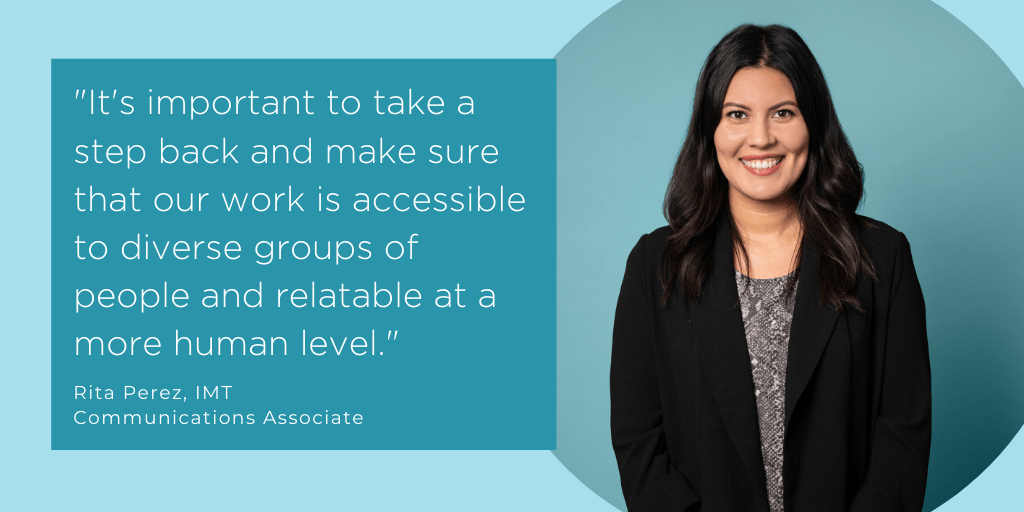In California, climate change has already infiltrated the lives of thousands of people, resulting in personal losses for countless families throughout the state’s increasingly deadly wildfires and businesses and cities reconsidering their long-term strategies in the face of California’s rising sea levels. Throughout all of these environmental changes, there is no question that under-resourced families will experience climate change in more devastating ways than better-resourced communities. For these families, access to resources makes all of the difference in their ability to stay safe and healthy amid a changing climate.
In this Q&A, IMT’s communications associate, Rita Perez—a former Angeleno—tells us how she learned about the urgency of climate action by witnessing the personal and community impacts of environmental injustice in Los Angeles.

What is one defining moment in your life where the reality of climate change became personal to you? How does your role as communications associate at IMT address some of these climate challenges that the world is currently facing?
I learned about environmental injustice long before I knew the meaning of the phrase. I grew up in Los Angeles a block away from the 405 freeway, one of the most congested freeways in the city, if not all of California. Growing up, there seemed to be no time of day when thousands of cars weren’t packed together, moving just inches at a time. What I didn’t know then, and what few people think about even now, is the impact that this never-ending traffic has on neighboring families and children inhaling all of that smog and air pollution.
My family and I lived in this house for 10 years, and it was in the beginning of my middle school years that I began to develop breathing problems. When I finally went to a doctor, he diagnosed me with asthma. I was an active, healthy kid, and I was confused by the diagnosis. Shortly after, An Inconvenient Truth came out and I was pretty much traumatized by that film–it forced me to look at the bigger picture of things. My health conditions, and those of my family and neighbors, no longer felt like isolated cases or results of a poor decision to choose a home surrounded by congested freeways and highways. Instead, I began to realize that it was part of a larger, structural and environmental problem that ran deeper than a simple choice my parents had made. I also understood very clearly after that film that our planet wasn’t in good shape and humans needed to get their act together if we wanted to preserve it.
With this newfound knowledge, I lived my life a little more carefully in hopes that my everyday choices would make some difference for the future of our planet. Now, as the communications associate for IMT, I play a direct role in sharing our public and private sector work with partner cities, organizations, and anyone else interested in learning how to address greenhouse gas emissions through building efficiency. Given the correlation between building energy use, greenhouse gas emissions, and climate change, I am proud to be part of IMT, where we take action on climate change by reducing emissions across the building sector. IMT’s work, and my work, tackles climate issues head on in a way that makes sense for everyone involved.
What experience or perspective do you bring to IMT that you’re contributing to the organization?
As IMT continues to expand its equity work and adopts more inclusive approaches to our programmatic work, I think that my life experiences and perspectives are helpful in navigating some of these internal organizational and cultural shifts. When attempting to change an organization’s culture, it can be challenging to realize that everyone’s learning journey will be different, but I’ve been really excited to support my colleagues in this process.
In addition to that, as someone without a dedicated background in energy or energy efficiency, it’s important to take a step back sometimes and question whether non-energy background folks are able to understand our work, and how we can engage with those people in a way that makes sense and that is relatable to them at a more human level. I’m happy to be part of a team that’s always looking to bring more people into our discussions.
What are some projects or issues or topics that you’re excited about working on in the upcoming year?
I’m excited to be part of IMT’s plans for a decade of action on energy and climate. We are expanding beyond how the sector has traditionally approached energy efficiency to take a more holistic approach that includes social issues. An example of our ongoing work is our focus on building performance standards, which set efficiency standards in buildings and that can be used as a platform for workforce development, air quality improvements, and renewable energy and electrification in cities.
I’m also excited about working alongside colleagues that are constantly searching for ways to make our work more impactful and inclusive. I have been part of IMT’s ongoing diversity, equity, and inclusion (DEI) initiatives through my participation in a working group organized by Georgetown’s Center for Public and Nonprofit Leadership, and as a member of the NAACP Centering Equity in the Sustainable Building Sector (CESBS) working group. Within these groups, participating organizations and companies brainstorm ways in which they can diversify their organizations and more thoughtfully serve their clients and stakeholders. Overall, being part of IMT has allowed me to represent communities in various ways, and it has been very fulfilling.
What are some IMT resources that have helped your own understanding of building efficiency work that you would recommend to other individuals who are new to this field?
Having a massive IMT resource library available for my onboarding process was extremely helpful. I was able to get a lot of information about nearly every IMT project that we’ve worked on. A few resources that I found helpful were the following:
- Energy Efficiency in Buildings: This fact sheet broke down the basics of energy efficiency and put a lot of environmental, social, and economic goals into perspective. In one sentence, this resource explains why energy efficiency and better building performance are essential to creating healthier, greener, and more thriving cities. A few months prior to joining IMT, Washington State adopted a building performance standard (BPS) through the Clean Energy Buildings Act and we were in the process of developing our Building Performance Standards factsheet – this resource clearly broke down the importance and potential impact of this policy in cities as well.
- City Energy Project: The City Energy Project resources (which can also be found in IMT’s resource library) were another extremely helpful set of tools and guides that explained all of the necessary steps for developing and implementing building efficiency policies in cities. This collection of resources took into account the variety of perspectives and interests that must be represented in the process of creating and offering energy efficiency programs, so getting a breakdown of these stakeholders was also beneficial to my understanding of our work.
- Green Lease Leaders case studies: A major barrier to building efficiency is what we call a split incentive between landlords who might want to invest in it and tenants who get a flat utility rate. Our Green Lease Leaders program is a partnership with the U.S. Department of Energy’s Better Building Alliance that addresses this barrier through mutually beneficial green leases. During my first few months at IMT, we wrapped up three case studies that featured the work of a 2019 Green Lease Leaders winners, including a case study highlighting three industrial building owners, and a case study on companies creating more sustainable co-working spaces. These industry profiles gave me a digestible overview of some specific strategies building owners can implement to make efficiency valuable to their tenants as well as their bottom line.
